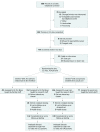Effectiveness of a Timing and Coordination Group Exercise Program to Improve Mobility in Community-Dwelling Older Adults: A Randomized Clinical Trial
- PMID: 28806436
- PMCID: PMC5710210
- DOI: 10.1001/jamainternmed.2017.3609
Effectiveness of a Timing and Coordination Group Exercise Program to Improve Mobility in Community-Dwelling Older Adults: A Randomized Clinical Trial
Abstract
Importance: Timing and coordination exercises may be an important addition to community-based health promotion exercise programs to improve walking in older adults.
Objective: To compare the effectiveness of the On the Move group exercise program, which focuses on the timing and coordination of movement, with a seated strength, endurance, and flexibility program (usual care) at improving function, disability, and walking ability of older adults.
Design, setting, and participants: Cluster-randomized, single-blind intervention trial. Thirty-two independent living facilities, senior apartment buildings, and senior community centers were randomized to On the Move (16 sites; 152 participants) or usual care (16 sites; 146 participants). Participants were 65 years or older, able to ambulate independently with a gait speed of at least 0.60 m/s, able to follow 2-step commands, and were medically stable.
Interventions: Exercise classes were 50 minutes, twice a week for 12 weeks and had 10 or fewer participants per class. On the Move consisted of warm-up, timing and coordination (stepping and walking patterns), strengthening, and stretching exercises. The usual-care program consisted of warm-up, strength, endurance, and stretching exercises.
Main outcomes and measures: The primary outcomes were self-report of function and disability (Late Life Function and Disability Instrument) and mobility (6-minute walk distance and gait speed) assessed by blinded individuals.
Results: Participants (mean [SD] age, 80.0 [8.1] years) were mostly female (251 [84.2%]) and white (249 [83.6%]) and had a mean (SD) of 2.8 (1.4) chronic conditions. Intervention groups were similar on baseline characteristics. Postintervention, 142 (93.4%) participants in On the Move and 139 (95.2%) participants in usual care completed testing. On the Move had greater mean (SD) improvements than the usual-care group in gait speed (0.05 [0.13] vs -0.01 [0.11] m/s; adjusted difference = 0.05 [0.02] m/s; P = .002) and 6-minute walk distance (20.6 [57.1] vs 4.1 [55.6] m; adjusted difference = 16.7 [7.4] m; P = .03). Attendance was greater in the usual-care program compared with On the Move (95 [65.1%] vs 76 [50.0%] attended ≥20 classes; P = .03). There were no significant differences in any of the other primary or secondary outcomes.
Conclusions and relevance: The On the Move group exercise program was more effective at improving mobility than a usual-care exercise program, despite lower attendance. Additional research examining the impact of the intervention on long-term disability outcomes is needed before recommending routine implementation into clinical practice.
Trial registration: clinicaltrials.gov Identifier: NCT01986647.
Conflict of interest statement
Figures
References
-
- Cesari M, Kritchevsky SB, Penninx BW, et al. . Prognostic value of usual gait speed in well-functioning older people—results from the Health, Aging and Body Composition Study. J Am Geriatr Soc. 2005;53(10):1675-1680. - PubMed
Publication types
MeSH terms
Associated data
Grants and funding
LinkOut - more resources
Full Text Sources
Other Literature Sources
Medical


